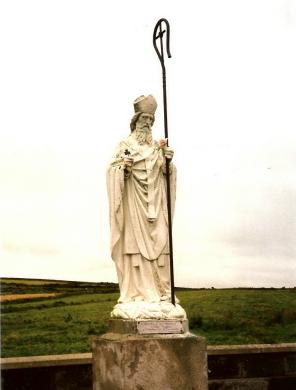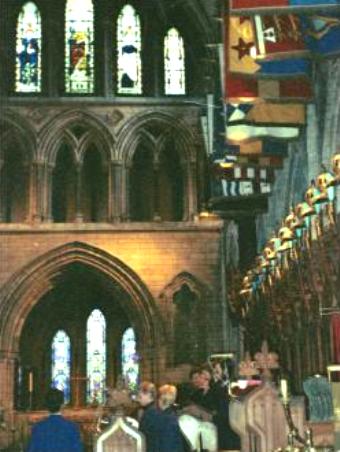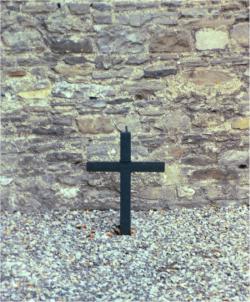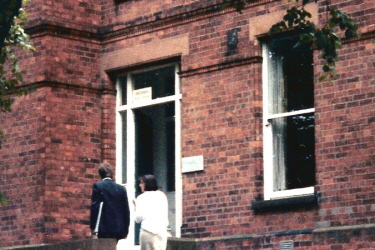|
This essay appeared in the National Catholic Register, November 4, 1990; minor revisions made in 2001 & 2007. Copyright © 1990-2007 by Mary Meehan. Models of Peace from Irish History Mary Meehan You've heard about the bitter Irish memories of lost battles, informers, the Irish Civil War, and the "Troubles" in the North of Ireland. Irish people on each side of the "Troubles" often have used the many negatives of their history to justify violence against the other side. There is another Irish history, though, one too often overlooked. It's a story of reconciliation, starting with St. Patrick and continuing today.
 Statue of St. Patrick at Foghill, County Mayo, where The little village of Foghill (pronounced FO-hill) lies on the edge of Lackan Bay and the Atlantic Ocean. Scholars believe this is the place Patrick called "the Wood of Foclut, which is near the western sea." It's the only place in all of Ireland that he mentioned by name in his "Confession." St. Patrick was British--probably born in England, although some say Wales or Scotland. When he was 16, he was captured by Irish raiders and enslaved for six years, apparently spending at least part of that time at present-day Foghill. After his escape and return to Britain, he had a dream in which he heard the Irish near Foclut cry out, "We beseech you, holy boy, to come and walk among us once again." His sense of mission to the Irish was so strong that he was able to overcome memories of his capture and his lonely life as a slave, tending sheep on a mountain. Writing in America magazine in 1986, Edmond Grace, S.J., said that "what Patrick did stands unequaled as a gesture of reconciliation. He returned to the people who had destroyed the comfortable expectations of his youth and lived among them so that the Good News might be heard 'in places beyond which no one lives.'" Today there is no longer a great forest at Foghill. But you'll see some trees in the village and rolling green farmland all around it. If you walk down toward the quiet bay and look to your right, you'll see sheep grazing. It's easy to imagine a youthful Patrick tending a flock like this nearly 1,600 years ago. It is fitting that St. Patrick's Cathedral in Dublin has a special sign of reconciliation. It's a very old and battered door, with a hole cut through its center. In 1492 Gerald Fitzgerald (Earl of Kildare) and his men were pursuing James Butler (Earl of Ormond) and his followers. Butler took refuge in the cathedral's chapter house. Fitzgerald, according to a cathedral account, decided that "the feuding was foolish. Here were two families worshiping the same God, in the same church, living in the same country, trying to kill each other." So Fitzgerald called out to Butler a promise that he wouldn't be harmed. Butler, fearing a ruse, didn't respond. Fitzgerald cut a hole in the door and put his hand through it. Someone inside grasped his hand, the door opened, and the fight was over. In the midst of any feud, suggests the cathedral account, "If one of us would dare to 'chance his arm,' perhaps that would be the first crucial step to the reconciliation we all unconsciously seek."
 St. Patrick's Cathedral, Dublin Also in Dublin is a less obvious scene of forgiveness: the grim Kilmainham Jail, where leaders of the 1916 Rising were executed by the British. Guides give an excellent tour of the old dungeon. The execution of James Connolly was a special source of bitterness to Irish nationalists because Connolly had been badly wounded during the Rising and was not able to stand. The British carried him in an ambulance to the Kilmainham Jail, placed him in a chair in the stonebreaker's yard, and shot him in the chair. Connolly himself faced death with a remarkable lack of bitterness. The night before, he had been awakened at 11 and told that he was to be shot at dawn. He was allowed to see his wife and one of his children. "But your beautiful life, James," his wife cried. "Your beautiful life." "Hasn't it been a full life, Lillie?" he asked. "And isn't this a good end?" Just before the execution, the Catholic priest who had given Connolly the last rites asked him if he would pray for the men who were about to shoot him. He replied, "I will say a prayer for all brave men who do their duty according to their lights."  Cross Shows where James Connolly Died Six years later, a Church of Ireland clergyman accompanied Erskine Childers to his execution in another Dublin prison yard. Childers was one of 77 men executed by the Irish Free State for resisting the Anglo-Irish treaty because it failed to give Ireland full independence. Since he had played a key role in the independence struggle, his execution increased the great bitterness of the Irish Civil War. But Childers himself, seeing his oldest son for the last time, told the boy he must shake hands with those responsible for his father's death and, if he ever entered Irish politics, he must not speak of the execution. The English-born Childers wrote his wife, "I die loving England and passionately praying that she may change completely and finally towards Ireland." Just before he was shot, he shook hands with each soldier in the firing squad. If you go north to Belfast and walk up the Shankill Road, a militantly Protestant-loyalist neighborhood, you're likely to see graffiti supporting loyalist paramilitaries. Fourteen years ago, however, the Shankill was the scene of reconciliation. On Aug. 28, 1976, Catholics from the Falls Road met Protestants from the Shankill and marched together up to Woodvale Park. Some 35,000 strong, they sang hymns and prayed and listened to talks by Peace People leaders. The year of the great peace marches now seems far in the past. Yet many who marched that day are still active in efforts to make peace between Protestants and Catholics in the North. They do educational work, civil disobedience of a peaceful nature, or political work. Although discouraged at times, some say they see great changes in young people they work with. Some know paramilitary members who have turned to peace. The Catholics among them remember another rally, in 1979, when Pope John Paul II addressed a great crowd at Killineer. "Now I wish to speak to all men and women engaged in violence," he said. "I appeal to you, in language of passionate pleading. On my knees I beg you to turn away from the paths of violence and to return to the ways of peace." Those who respond to his plea will find in Irish history many powerful models to follow.
 Peace People Headquarters, Belfast Postscript: In recent years, Ireland followed a "peace process" that reduced violence in the North and finally led to a government there formed by old enemies who believe they can now work together. At critical points, they were willing to "chance their arms." |